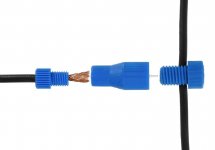Haha, you're not going to like it. Buy once cry once and get a fluke.
For tracing wires, almost anything would work. I used to be ok with the innova ones from Canadian Tire but I had one where all measurements were 30% low. Not cool and causes a lot of head scratching if you don't have something else to compare it to and see that the meter is cacked. Canadian tire puts meters on sale half price often. They will be fine for tracing wires and general maintenance on vehicles. I have used those for AC in the past but there are some clear safety issues when doing that so be very careful. Two meters are helpful to compare readings or get voltage and amperage at the same time. When I was buying cheap meters I avoided autoranging as cheap autoranging was far too slow and would drive you nuts as it missed spikes. I'm not sure if that has improved with modern cheap meters.
EDIT:
I didn't look at the specs but from the picture, there isn't much that this one won't do and it's $35. Cat IV 600V rated (doesn't blow up in your face if you screw up), capacitance (home a/c compressor or furnace fan not working, probably cap died), duty cycle (more and more vehicle lights are using PWM), manual range if you want it, backlit, etc. It doesn't look like it can do temperature but I rarely use a multimeter for temp anyway. It doesn't do true RMS but you probably don't care about that.










.jpg)








